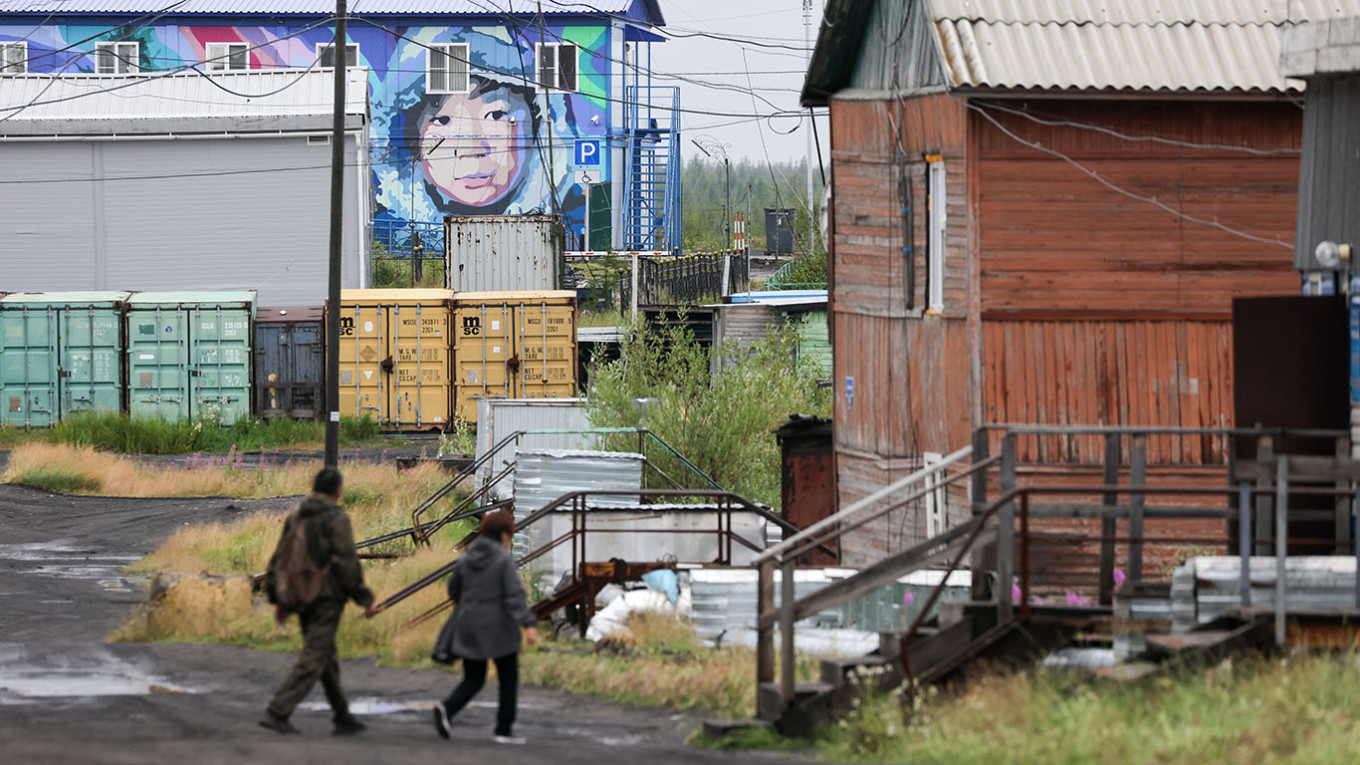For several months, Kseniia Bolshakova’s sister has faced difficulties providing food for her family in Khatanga, a remote village with a population of 2,500 that ranks among Russia’s northernmost communities.
“She mentioned they haven’t been able to eat well for two months due to food scarcity,” Bolshakova, an Indigenous Dolgan activist, shared with The Moscow Times.
Since all supplies must be airlifted, the village experiences persistent food shortages, Bolshakova explained.
“When a plane carrying food arrives, residents rush to the stores to secure a place in the long queue,” she noted. The shops implement a rationing system “to prevent any single family from buying all the potatoes available.”
While Russia showcases the resource wealth of its Arctic regions to attract investment from Washington and Beijing in energy and rare earth mineral extraction, the Indigenous peoples in these Arctic areas are unlikely to benefit from such initiatives.
Experts and activists suggest that, instead, these communities will continue to live in dire poverty, grappling with the gradual degradation of their local environments and the erosion of their traditional lifestyles.
The Dolgans, a Turkic ethnic group of just over 8,000 people, mostly inhabit their ancestral lands in the Taimyr peninsula above the Arctic Circle, part of the Taimyrsky Dolgano-Nenetsky district in Krasnoyarsk region.
Bolshakova grew up herding reindeer, fishing, and gathering berries in the tundra—activities representative of the Dolgans’ traditional nomadic existence that is now sustained by fewer than ten families in the region.
The shadows of Soviet enforced sedentarization, state neglect of reindeer herders, along with climate change and pollution, have all pushed Dolgans away from their traditional ways and toward urban centers.
However, living in Arctic towns presents its own set of challenges despite being depicted as bountiful in many narratives highlighting the area’s geopolitical significance.
Many communities lack adequate sewage systems, running water, and central heating. Food rationing is a common occurrence, healthcare services are rarely accessible, and state television often serves as the only news source in regions with limited internet connectivity.
Bolshakova’s hometown of Popigai, which has around 300 residents, is devoid of water and sewage facilities. Coal-powered heaters are used to keep warm during the lengthy winter months.
“In the summer, water is delivered to homes using a tractor with a large water tank. In winter, people rely on snowmobiles to cut ice blocks from the river,” recalled Bolshakova, who now lives in exile.
Expired food is another common aspect of life there.
“People have grown accustomed to rarely finding quality products that haven’t spoiled,” she said. “When I lived in Khatanga, we often purchased expired milk because it was more affordable…for baking or cooking. Fresh milk for drinking was a rarity, either because it was hard to find or outrageously priced.”
As Indigenous communities fight for survival, their territories are gaining increasing geopolitical importance on a global scale.
With control over more than half of the Arctic Ocean’s coastline, Russia is courting partners from Washington to Beijing to create new shipping routes and extract vital minerals as the area continues to warm.
The choice of Alaska for last month’s landmark meeting between Presidents Donald Trump and Vladimir Putin underscored the strategic significance of the region.
However, these geopolitical considerations seldom reflect the realities faced by local populations.
“The entirety of the Russian Arctic is Indigenous territory,” stated Lana Pylaeva, an advisor on Indigenous rights at Arctida, a non-governmental organization engaged in research and analyses of the Russian Arctic.
“Russia’s official narrative continues to portray the Arctic as an uninhabited land to be ‘developed,’ often employing severely exploitative methods,” Pylaeva mentioned to The Moscow Times.
For Indigenous communities, the real concern is less about which foreign entity will exploit their ancestral lands, and more about how they will manage to survive.
“To Indigenous people, it hardly matters whether Russia will exploit the Arctic independently or with the U.S.,” remarked Sargylana Kondakova, co-founder of the Free Yakutia Foundation, a leading Indigenous rights organization in the Sakha (Yakutia) republic.
“China is proposing to build a railway straight into Sakha. But for what purpose— to facilitate travel for locals? Absolutely not,” Kondakova asserted.
“They’re doing this to import cheap labor and extract our forests and resources,” she stated, highlighting that incoming industries rarely aim to hire locals, who are often more inclined to raise concerns about potential illegal activities.
“It’s all about geopolitics. Ordinary people stand to gain nothing from it,” she said.
Kondakova, who was born and raised in the Arctic village of Chokurdakh in northeastern Sakha, noted that the Yukaghir people, the Indigenous group she belongs to, number just over 1,500 worldwide.
What was once sustained by a substantial Soviet military presence, Chokurdakh is now characterized by vacant apartment buildings, overpriced expired food, and a youth exodus to larger Russian cities.
“Alcoholism represents another critical issue in the Arctic,” Kondakova highlighted.
Sakha consistently ranks among the top Russian regions for alcohol consumption per capita and related fatalities. Chukotka, the easternmost region that borders Alaska, leads this statistic, according to the data project Esli Byt Tochnym.
“Unlike food supplies, alcohol deliveries are abundant,” the activist elaborated. “And the quality is generally very low.”
While some residents have attempted to revive traditional fishing methods to feed their families, many have found that pollution from resource extraction industries has severely depleted fish populations.
Life in Chukotka to the east mirrors these challenges.
“Russian authorities have repeatedly declared the Arctic as a ‘priority development zone,’ yet in practice, this primarily pertains to oil and resource extraction endeavors,” explained Mark Zdor, a Chukotka native and member of the International Committee of Indigenous Peoples of Russia.
“Indigenous peoples of the Russian North, including those in Chukotka, do not feel prioritized at all. The cost of living remains extraordinarily high. Even with food subsidies, it only covers the most basic needs,” Zdor told The Moscow Times.
Extractive companies worldwide, as well as those in Russia, increasingly cite international standards that require the free, prior, and informed consent of Indigenous communities before commencing operations.
However, activists argue that companies exploit ambiguous regulations and align themselves with Indigenous advocates who are loyal to their interests and to the Kremlin, reducing a protective measure aimed at safeguarding Indigenous rights to a mere formality.
Operating under questionable environmental standards, activists assert that extractive companies and associated construction projects threaten local ecosystems, hastening the disappearance of Indigenous communities and their traditional lifestyles, all while offering minimal compensation in return.
The presence of abundant mineral resources suggests that Russian firms may soon be joined in the Arctic by American counterparts, advancing bilateral economic cooperation.
However, few experts or locals have faith that American involvement will improve environmental or social protections.
“The tundra resembles a bog, with just a thin layer of vegetation that holds the soil together. When this surface is disturbed, it becomes nothing but mud where reindeer can sink… These areas become channels for greenhouse gas release, accelerating permafrost thawing,” Pylaeva explained.
“That is to say, the environmental repercussions of critical minerals exploration will be substantial,” she stated.
At best, she continued, U.S. involvement might allow international observers rare access to sites that are currently inaccessible to independent Russian monitors and Indigenous advocates.
Nonetheless, activist Bolshakova warns that some Indigenous people could be forcibly relocated to larger towns to avoid disrupting extraction efforts.
“During the Soviet sedentarization, people were already forced from the tundra into settlements. Now, there’s a fear they might again be moved from these settlements… to larger towns,” Bolshakova, who is only the second person globally to have written prose in the endangered Dolgan language, cautioned.
“The larger towns predominantly have a Russian population, where assimilation is likely to occur even more rapidly,” she remarked. “Ultimately, all that will remain of the Dolgans is merely a name, a memory of once-thriving reindeer herders in the tundra who have morphed into average Russian citizens living in urban areas.”

